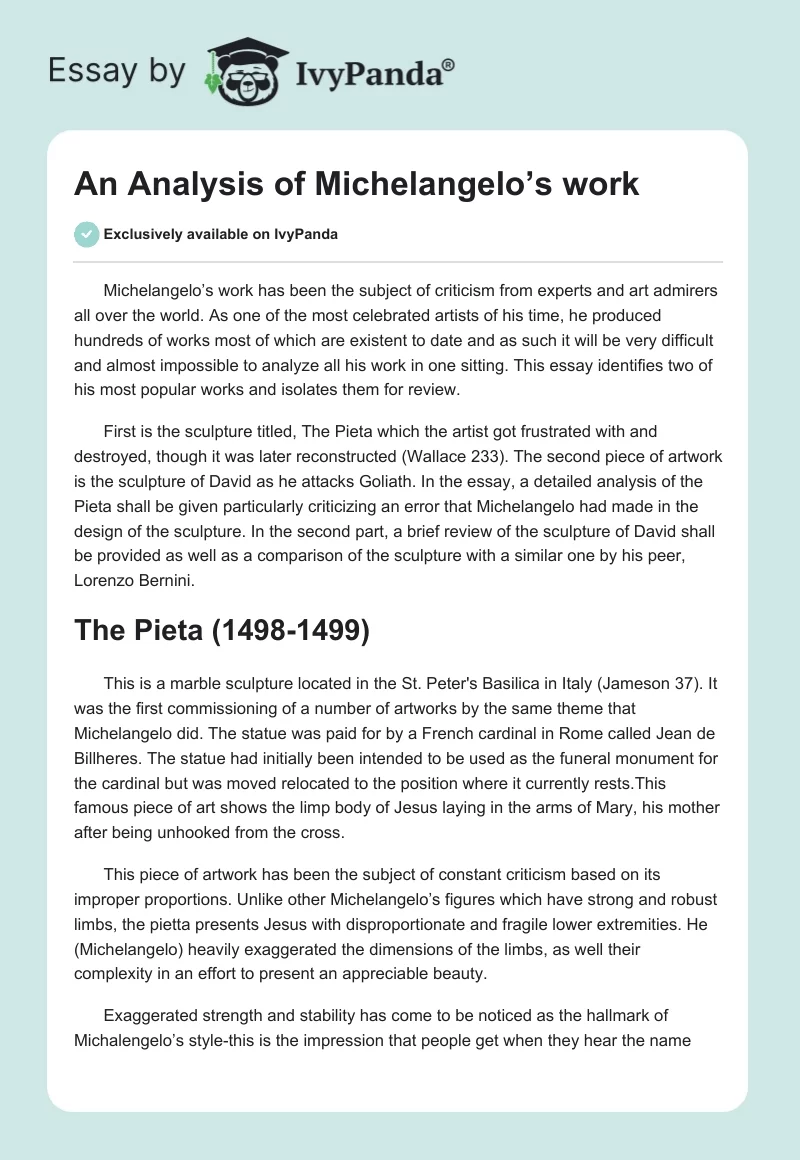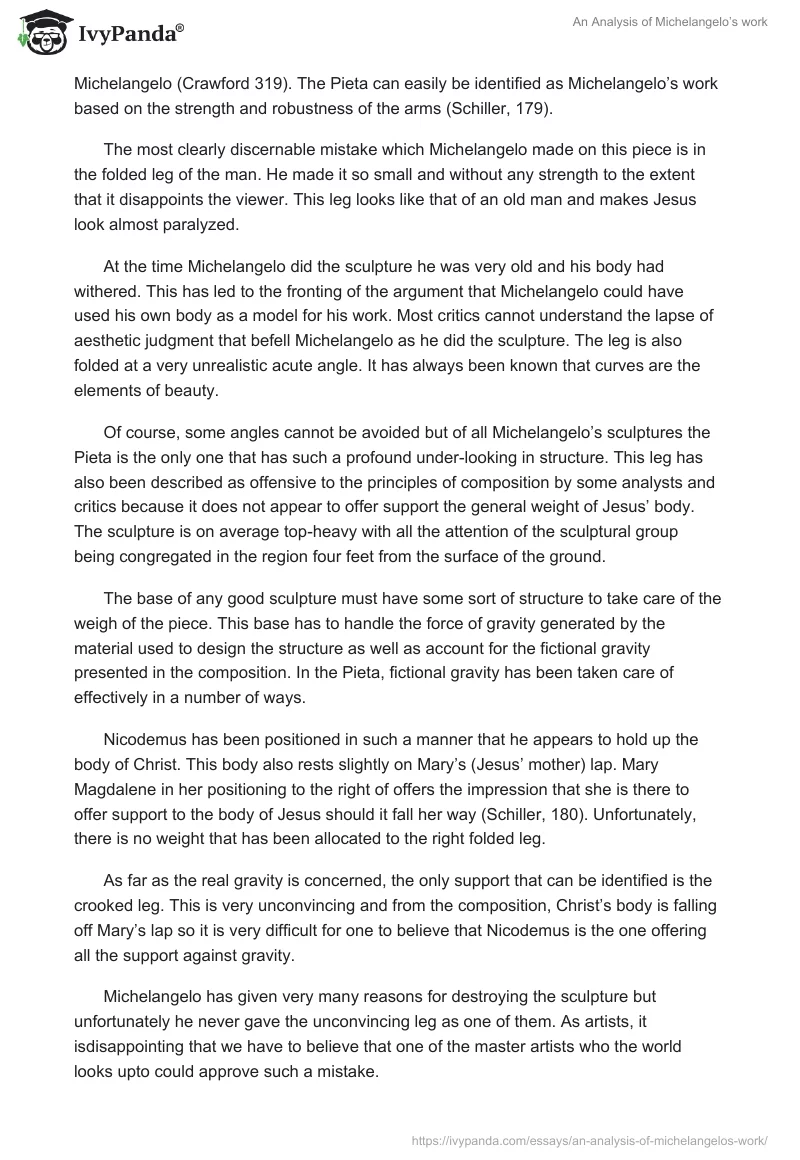Michelangelo’s work has been the subject of criticism from experts and art admirers all over the world. As one of the most celebrated artists of his time, he produced hundreds of works most of which are existent to date and as such it will be very difficult and almost impossible to analyze all his work in one sitting. This essay identifies two of his most popular works and isolates them for review.
First is the sculpture titled, The Pieta which the artist got frustrated with and destroyed, though it was later reconstructed (Wallace 233). The second piece of artwork is the sculpture of David as he attacks Goliath. In the essay, a detailed analysis of the Pieta shall be given particularly criticizing an error that Michelangelo had made in the design of the sculpture. In the second part, a brief review of the sculpture of David shall be provided as well as a comparison of the sculpture with a similar one by his peer, Lorenzo Bernini.
The Pieta (1498-1499)
This is a marble sculpture located in the St. Peter’s Basilica in Italy (Jameson 37). It was the first commissioning of a number of artworks by the same theme that Michelangelo did. The statue was paid for by a French cardinal in Rome called Jean de Billheres. The statue had initially been intended to be used as the funeral monument for the cardinal but was moved relocated to the position where it currently rests.This famous piece of art shows the limp body of Jesus laying in the arms of Mary, his mother after being unhooked from the cross.
This piece of artwork has been the subject of constant criticism based on its improper proportions. Unlike other Michelangelo’s figures which have strong and robust limbs, the pietta presents Jesus with disproportionate and fragile lower extremities. He (Michelangelo) heavily exaggerated the dimensions of the limbs, as well their complexity in an effort to present an appreciable beauty.
Exaggerated strength and stability has come to be noticed as the hallmark of Michalengelo’s style-this is the impression that people get when they hear the name Michelangelo (Crawford 319). The Pieta can easily be identified as Michelangelo’s work based on the strength and robustness of the arms (Schiller, 179).
The most clearly discernable mistake which Michelangelo made on this piece is in the folded leg of the man. He made it so small and without any strength to the extent that it disappoints the viewer. This leg looks like that of an old man and makes Jesus look almost paralyzed.
At the time Michelangelo did the sculpture he was very old and his body had withered. This has led to the fronting of the argument that Michelangelo could have used his own body as a model for his work. Most critics cannot understand the lapse of aesthetic judgment that befell Michelangelo as he did the sculpture. The leg is also folded at a very unrealistic acute angle. It has always been known that curves are the elements of beauty.
Of course, some angles cannot be avoided but of all Michelangelo’s sculptures the Pieta is the only one that has such a profound under-looking in structure. This leg has also been described as offensive to the principles of composition by some analysts and critics because it does not appear to offer support the general weight of Jesus’ body. The sculpture is on average top-heavy with all the attention of the sculptural group being congregated in the region four feet from the surface of the ground.
The base of any good sculpture must have some sort of structure to take care of the weigh of the piece. This base has to handle the force of gravity generated by the material used to design the structure as well as account for the fictional gravity presented in the composition. In the Pieta, fictional gravity has been taken care of effectively in a number of ways.
Nicodemus has been positioned in such a manner that he appears to hold up the body of Christ. This body also rests slightly on Mary’s (Jesus’ mother) lap. Mary Magdalene in her positioning to the right of offers the impression that she is there to offer support to the body of Jesus should it fall her way (Schiller, 180). Unfortunately, there is no weight that has been allocated to the right folded leg.
As far as the real gravity is concerned, the only support that can be identified is the crooked leg. This is very unconvincing and from the composition, Christ’s body is falling off Mary’s lap so it is very difficult for one to believe that Nicodemus is the one offering all the support against gravity.
Michelangelo has given very many reasons for destroying the sculpture but unfortunately he never gave the unconvincing leg as one of them. As artists, it isdisappointing that we have to believe that one of the master artists who the world looks upto could approve such a mistake.
The sculpture of David
In the sculpture of David by Michelangelo, he (David) is portrayed on one part as the ideal man, and as an adolescent youth in the other part. Unlike his predecessors who depicted David with the macabre head of the slain giant under his foot (Nordlander 2967). Michelangelo sculpts David in the instance that he is just facing the giant before the attack. It is almost as if he believed that this was David’s moment of unchallenged courage.
The sculpture is based on a drawing of the masculine human figure and has one leg receiving the whole weight of the sculpture alongside gravitational forces while the other leg rest a few inches infront. One hand holds the sling to the back of the figure while the other hand rests on the side. The head and torso are slightly larger than the proportions of other elements within the lower body.
Comparison between Michelangelo’s David and the one done by Gian Lorenzo Bernini
Michelangelo’s David is a clear representation of the average sculpture from the Renaissance period. It does not necessarily show any creativity in the sense that it is an almost exact representation of the real person and scene-it is just a portrait sculpture. In Roman copies of ancient Greek statues, some sort of structural support has to be provided for the sculpture and this one by Michelangelo is no different.
The sculpture of David is presented in contrapposto, with some sort of tension and watchfulness in his face. Michelangelo gave this sculpture an almost child like face clear of any emotion. He (Michelangelo) showed movement in only one arm of the sculpture and some little motion in the turning of the head.
Gian Lorenzo Bernini on his part created a dramatic representation of the hero. He not only shows the anger that is boiling within him (David) but also provides the insinuation that he is ready to confront the danger that is ahead of him. In the sculpture, David is on the attack with a loaded sling on his hand.
The muscles on his upper arms are tense and an almost mocking grimace is shown on the face. Unlike Michelangelo’s work, the sculpture of David by Bernini looks exactly his age, and has some little clothing on; Michelangelo’s David is totally naked. Bernini took time to show movement in the head, the arm and the torso while doing the sculpture.
Conclusion
It is worth noting that Michelangelo may well be the most celebrated artist of the 17th century. This is probably why any small mistake in his artwork cannot go unnoticed as has been illustrated by the analysis of the Pieta above. Many of his peers also went ahead to try and do similar work to his; for example, Bernini’s imitation of the sculpture of David.
However, history has gone to prove that his (Michelangelo’s) work could not be duplicated as Bernini’s David, though arguably superior to Michelangelo’s has never attracted much audience. Finally, as has been revealed in this paper analyzing a great artist’s work will take more than a few pages and that convincing the entire world to have a particular point of view as regards the work of a master artist is impossible.
Works Cited
Crawford, Francis. Ave Roma immortalis: studies from the chronicles of Rome. United States: Macmillan Co., 1899. Print.
Jameson, Anna. Legends of the Madonna: as represented in the fine arts. United States: Kessinger Publishing, 2006. Print.
Nordlander, Brage. “Michelangelo’s David has a squint.” Medline 102.41. (2005): 2967.
Print Schiller, Gertrud. Iconography of Christian Art. London: Lund Humphries, 1972. Print.
Wallace, William. Michelangelo, Life and Early Works: Selected Scholarship in English.
United Kingdom: Garland, 1995. Print.


